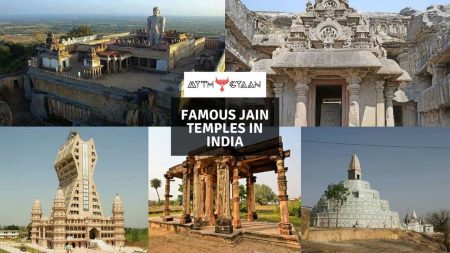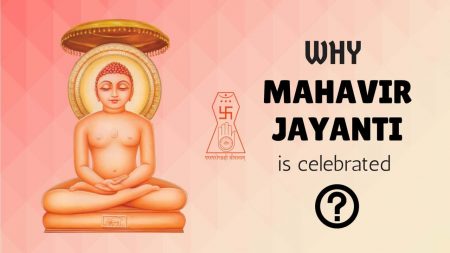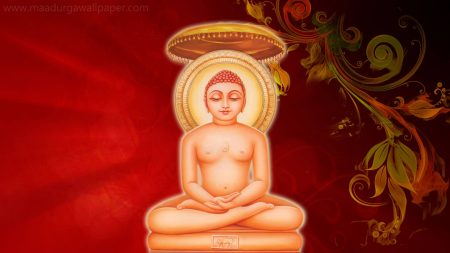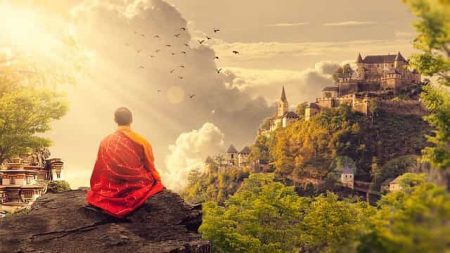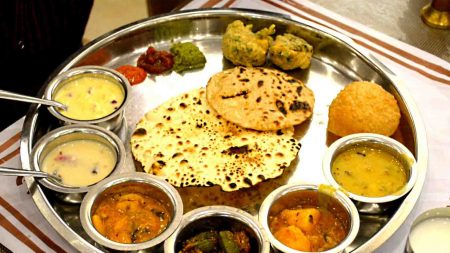What is the difference between Svetambara and Digambara in Jainism? There are two main sects in Jainism – Svetambara and Digambara. Both agree on the fundamental Jain principles and the five vows in Jainism. However, both have different views when it comes to scriptures, liberation, dress, the birth of Mahavira etc.
Digambara means “sky-clad” i.e. naked and Svetambara means “white-clad”, that’s why they wear white clothes.
Table of Contents
- 1. Difference between Svetambara and Digambara:
- 1.1 (1) Liberation of Woman:
- 1.2 (2) Dress:
- 1.3 (3) Possessions (संपत्ति):
- 1.4 (4) Birth of Mahavira:
- 1.5 (5) The marriage of Mahavira:
- 1.6 (6) Idols:
- 1.7 (7) Scriptures:
- 1.8 (8) Food:
- 1.9 (9) 19th Tirthankara Mallinatha:
- 1.10 (10) Time of Birth and Death of Mahavira:
- 1.11 (11) Namokar Mantra:
- 1.12 (12) Other differences between Svetambara and Digambara:
Difference between Svetambara and Digambara:
(1) Liberation of Woman:
This is one of the main differences between Svetambara and Digambara.
Digambara believes that women cannot achieve nirvana or liberation directly. They first have to reborn as a man for this. They give two reasons for this:
- Digambara monks are completely naked. This is not possible for women as they have to possess clothes. It is impractical for women in this society to live naked. Due to this they cannot lead the life of a true monk and hence cannot achieve liberation.
- Digambaras also believe that women are inherently himsic. It is due to the belief that menstrual blood kills micro-organisms living in the female body. Though there is no scientific evidence and this view is not found in modern Jain thinking.
Svetambara, on the other hand, have a different opinion. According to them, women are equally capable of achieving liberation as a man. They believe in Sabastra Mukti.
They believe that anybody can achieve salvation, be it a householder or a monk.
(2) Dress:

Digambara believes that in order to achieve nirvana or liberation, one must renounce everything including clothes. Therefore Digambara monks are completely naked.
Svetambara, on the contrary, believes that practice of nudity is not essential to attain liberation. Therefore they wear white clothes.
However, nuns in both the sects wear white clothes.
(3) Possessions (संपत्ति):
Digambara monks are not allowed to have any kind of possessions. They believe that it is necessary to renounce everything to lead the life of a true monk. However, they usually carry three things with them:

- Picchi – broom made up of fallen feathers of a peacock. They use this broom to remove small insects without harming them.
- Kamandalu – oblong water pot used for carrying pure and sterilized drinking water.
- Shastra – scriptures.
Svetambara monks are allowed to possess 14 specified things, which include:
- White clothes
- Rajoharaṇa – broom made up of soft white wool attached to a wooden handle.

Using this they remove small insects from their path without harming them.
- Begging bowl
- Books, etc.
(4) Birth of Mahavira:
Svetambara Jains believe that Mahavira’s embryo was first formed in Brahmin lady, Devanand. But the change of embryo happens because of God Indra’s army commander, Hari-Naigamesin (also known as Kartikeya) on the 83rd day after conception.
The embryo is transferred to a Kshatriya lady, Trisala, who is the wife of King Siddhartha.
Digambara Jains do not accept this story.
Also, Svetambara Jains believe that Mahavira’s mother has 14 auspicious dreams before his birth. However, Digambara Jains believe that she has 16 dreams instead of 14.
(5) The marriage of Mahavira:
Svetambaras believe that before renouncing the worldly life, Mahavira is married to princess Yasoda. Also, he has a daughter named Priyadarsana (also known as Anojja) through her.
Digambaras do not believe in this. According to them, Mahavira’s parents wanted him to marry Yasoda, but he refused this proposal.
Thus, they believe that Mahavira is Bal Brahmachari i.e. he never married and remain celibate during his lifetime.
MUST READ: Five Great Vows (Maha-vratas) of Jainism taken by Jain Monks & Layman
(6) Idols:

Svetambara idols of Tirthankars are decorated with jewels, wearing loincloth with prominent staring eyes. However, Digambara idols are naked, undecorated with downcast eyes.
(7) Scriptures:
In Jainism, the discourse delivered by Tirthankaras is known as Śhrut Jnāna. It comprises of 11 Angas and 14 Purvas.
Digambara holds the opinion that original texts of Jainism were lost ago.
Svetambara believes that they have the original Jain scriptures. However, they also accept that their collection is also incomplete.
Tattvartha Sutra is the probably the most authoritative text in Jainism, accepted by both Svetambara and Digambara.
(8) Food:
8.1 For Ascetics (Monks):
Svetambara monks collect their food in a bowl. They can seek and collect food freely given to them, from more than one household. Also, they can eat more than once in a day.
Digambara monks are strict in the sense that they eat food only once in a day. They cannot use a bowl to collect food.
So they collect it using their hands and then eat it from their hands only. They only collect food from one household, only where their Sankalpa (preconceived idea) is fulfilled.
8.2 For Kevali (Omniscient):
This is one of the important difference between Svetambara and Digambara.
Digambara believes that once a monk attains omniscience (Kevala Jnana), then he does not need to food to survive.
Svetambara Jains have a different opinion on this. They consider that until Kevali (or omniscient), male or female has not abandoned the body, they need food for the nourishment of the body.
(9) 19th Tirthankara Mallinatha:
Digambara Jains believe that Mallinatha was a male.
On the contrary Svetambara Jains believe that Mallinatha was a female by the name Malli.
(10) Time of Birth and Death of Mahavira:
- Birth of Mahavira according to:
- Digambara Jains – 582 BC
- Svetambara Jains – 599 BC
- Death of Mahavira according to:
- Digambara Jains – 510 BC
- Svetambara Jains – 527 BC
(11) Namokar Mantra:
It is probably the most important prayer in Jainism.
Digambara Jains believe that one should recite only the first five lines of the Mantra.
However, Svetambara Jains hold that one should recite all the nine lines.
(12) Other differences between Svetambara and Digambara:
Svetambara recognizes Sabastra Guru but Digambara do not.
Svetambara believes that in Kaivalya condition, Mahavira is suffering from illness. However, Digambara holds the view that he is not suffering from any kind of illness.
MUST READ: Why Jains are vegetarians? Why Jains do not eat root vegetables?


